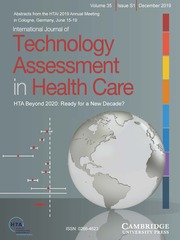Other
Acknowledgments
-
- Published online by Cambridge University Press:
- 31 December 2019, p. viii
-
- Article
-
- You have access
- HTML
- Export citation
Oral Presentations
OP06 Evaluating Public Health Interventions: A Neglected Area In HTA
-
- Published online by Cambridge University Press:
- 31 December 2019, p. 1
-
- Article
-
- You have access
- Export citation
OP10 Approaches To Gain Reimbursement For Medical Devices In Germany
-
- Published online by Cambridge University Press:
- 31 December 2019, pp. 1-2
-
- Article
-
- You have access
- Export citation
OP14 Progress In Use Of Telerehabilitation For Persons With COPD
-
- Published online by Cambridge University Press:
- 31 December 2019, p. 2
-
- Article
-
- You have access
- Export citation
OP15 Use Of Digital Health Information Among HIV Populations In Uganda
-
- Published online by Cambridge University Press:
- 31 December 2019, p. 2
-
- Article
-
- You have access
- Export citation
OP16 Assessing The Viability Of Medical Equipment Procurement In Hospital
-
- Published online by Cambridge University Press:
- 31 December 2019, pp. 2-3
-
- Article
-
- You have access
- Export citation
OP18 A Case Study Of Local Context-Dependent Decision-Making In Health Technology Assessment
-
- Published online by Cambridge University Press:
- 31 December 2019, p. 3
-
- Article
-
- You have access
- Export citation
OP19 Does The HST Represent A Best Practice Model For Ultra-Orphan HTA?
-
- Published online by Cambridge University Press:
- 31 December 2019, pp. 3-4
-
- Article
-
- You have access
- Export citation
OP20 Has The New HST Process Improved The Recommendation Chance In England?
-
- Published online by Cambridge University Press:
- 31 December 2019, p. 4
-
- Article
-
- You have access
- Export citation
OP21 Enhancing Capability: Patient Impact In Ultra-Orphan Conditions
-
- Published online by Cambridge University Press:
- 31 December 2019, p. 4
-
- Article
-
- You have access
- Export citation
OP22 Patient-Based Evidence: Its Role In Decision-Making On New Medicines
-
- Published online by Cambridge University Press:
- 31 December 2019, pp. 4-5
-
- Article
-
- You have access
- Export citation
OP23 Smart Searches For Context-Sensitive Topics: Geographic Search Filters
-
- Published online by Cambridge University Press:
- 31 December 2019, p. 5
-
- Article
-
- You have access
- Export citation
OP25 Organisational Learning Principles Applied To Information Retrieval
-
- Published online by Cambridge University Press:
- 31 December 2019, p. 5
-
- Article
-
- You have access
- Export citation
OP26 Search Approaches In Information Retrieval Presented In HTAi SuRe Info
-
- Published online by Cambridge University Press:
- 31 December 2019, pp. 5-6
-
- Article
-
- You have access
- Export citation
OP27 Engaging Patients: The EuroCAB Programme
-
- Published online by Cambridge University Press:
- 31 December 2019, p. 6
-
- Article
-
- You have access
- Export citation
OP28 Patient Involvement at AQuAS: Experiences And Reflections For Future
-
- Published online by Cambridge University Press:
- 31 December 2019, p. 6
-
- Article
-
- You have access
- Export citation
OP29 Building A Global, Public Repository Of Patient Experience Data
-
- Published online by Cambridge University Press:
- 31 December 2019, p. 7
-
- Article
-
- You have access
- Export citation
OP30 Impact Of Patient Reported Outcomes Data On Health Technology Assessments Of Acute Myeloid Leukemia
-
- Published online by Cambridge University Press:
- 31 December 2019, p. 7
-
- Article
-
- You have access
- Export citation
OP31 HTA And Patients’ Preferences: Starting A Discrete Choice Experiment
-
- Published online by Cambridge University Press:
- 31 December 2019, pp. 7-8
-
- Article
-
- You have access
- Export citation
OP33 Treatment Of Mitral Insufficiency And Multicriteria Decision-Making
-
- Published online by Cambridge University Press:
- 31 December 2019, p. 8
-
- Article
-
- You have access
- Export citation



